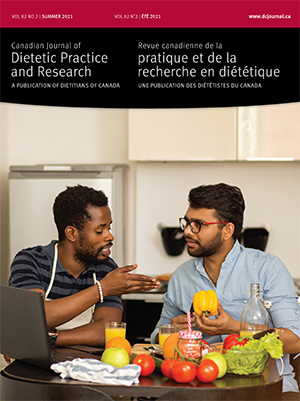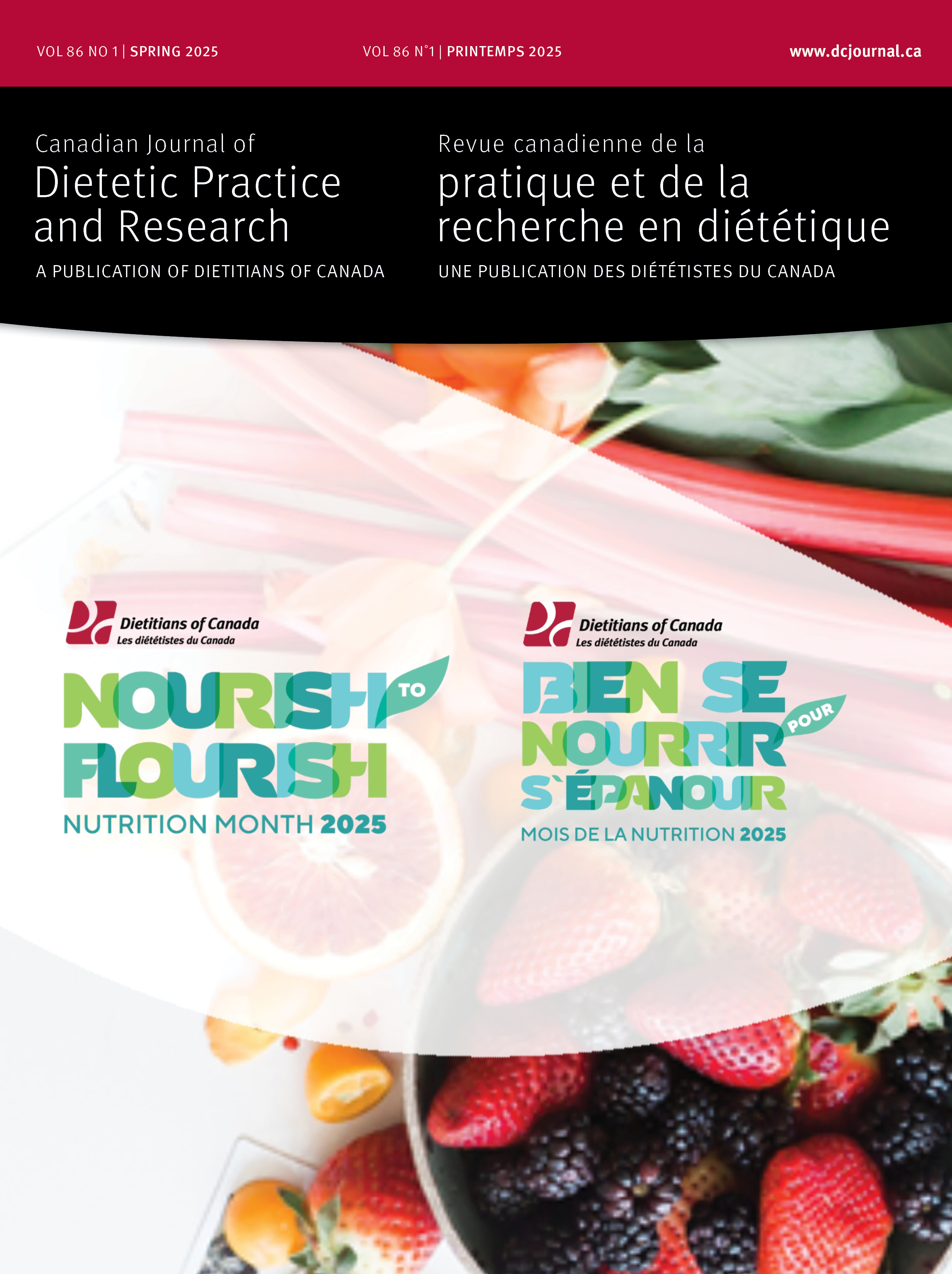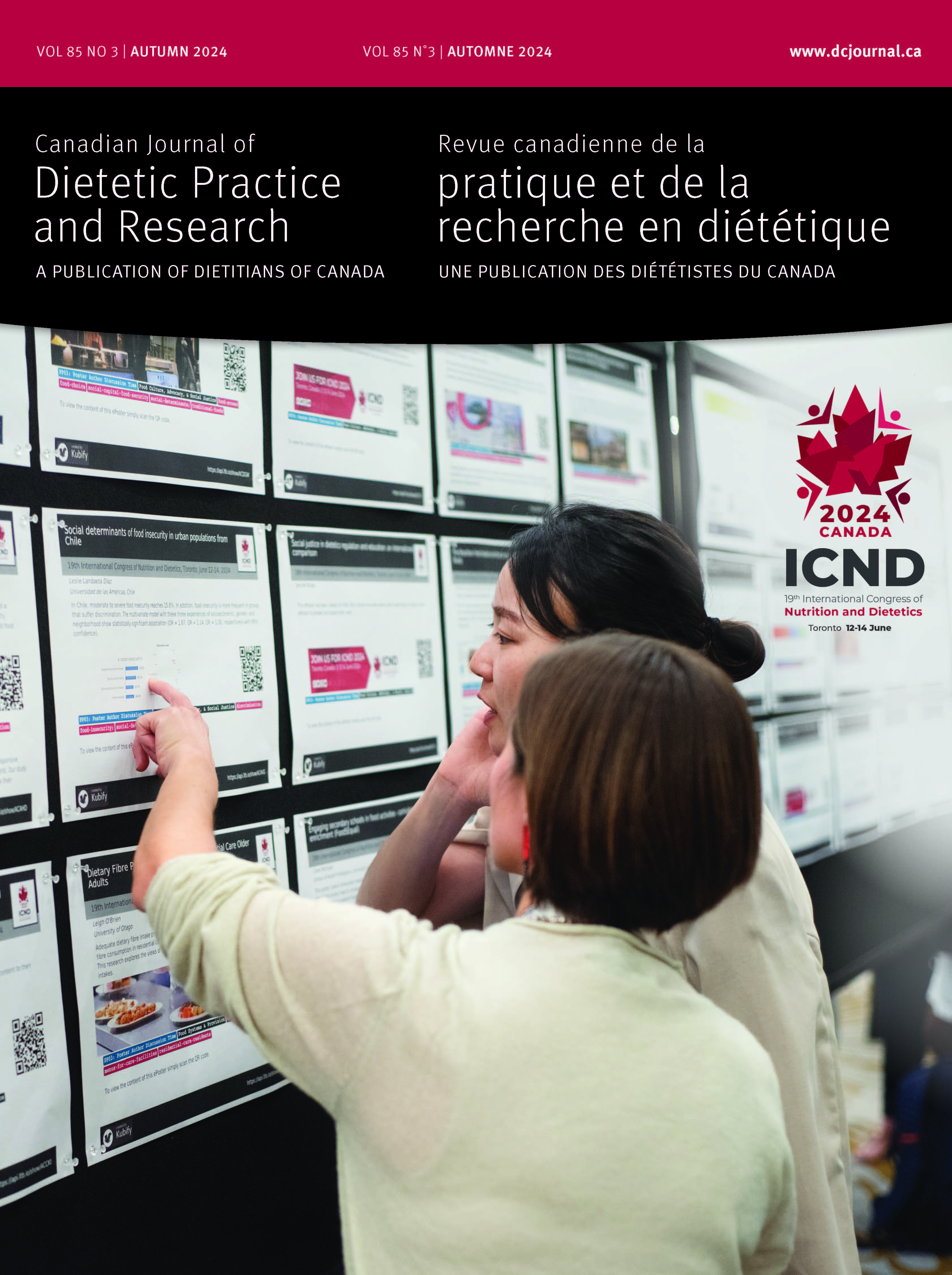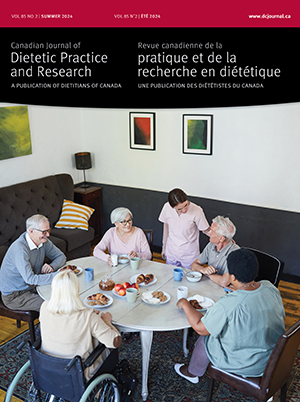Volume 82 • Number 2 • June 2021
Editor’s Message
Research
Purpose: This descriptive qualitative study explored young males’ perceptions of food skills in 3 domains: food selection and planning, food preparation, and food safety and storage.Methods: Semi-structured interviews were audio-recorded and transcribed verbatim. Data were analyzed using the constant comparative method.Results: Forty-four young men (aged 17–35) reported varying levels of food skills, from little/no confidence to very confident and skilled. Most participants learned food skills from their mothers. Greater involvement in food selection and planning at a young age appeared to be related to parental influence and encouragement, exposure to food skills at school, and interest in food-related activities, which, in turn, provided a solid foundation for being confident cooks as young adults. Most notable was the lack of knowledge about, or confidence in, food safety and storage. Young men with low self-perceived food skills were deeply embarrassed about this deficiency in front of peers who had higher levels of confidence and skills.Conclusions: Future interventions or curricula should emphasize food safety and storage. This research also illustrates the importance of the home environment in teaching food skills to youth and ensuring that food skills are taught well before young adults begin living independently.
Review
OPEN ACCESS
Despite the widespread use of statistical techniques in quantitative research, methodological flaws and inadequate statistical reporting persist. The objective of this study is to evaluate the quality of statistical reporting and procedures in all original, quantitative articles published in the Canadian Journal of Dietetic Practice and Research (CJDPR) from 2010 to 2019 using a checklist created by our research team. In total, 107 articles were independently evaluated by 2 raters. The hypothesis or objective(s) was clearly stated in 97.2% of the studies. Over half (51.4%) of the articles reported the study design and 57.9% adequately described the statistical techniques used. Only 21.2% of the studies that required a prestudy sample size calculation reported one. Of the 281 statistical tests conducted, 88.3% of them were correct. P values >0.05–0.10 were reported as “statistically significant” and/or a “trend” in 11.4% of studies. While this evaluation reveals both strengths and areas for improvement in the quality of statistical reporting in CJDPR, we encourage dietitians to pursue additional statistical training and/or seek the assistance of a statistician. Future research should consider validating this new checklist and using it to evaluate the statistical quality of studies published in other nutrition journals and disciplines.
Perspectives in Practice
The purpose of this exploratory research was to understand the experiences and learnings of dietetic and nutrition students following a 3-week intensive summer course designed to enhance students’ understandings of compassion, creativity, and sense of coherence as they apply to personal growth and socially just professional practice. Seven of 15 students participated in one-on-one, semi-structured interviews. Data analysis was conducted using inductive thematic analysis, resulting in 3 meta-themes: (i) personal meaning and sense making, (ii) relational and power dynamics, and (iii) disruption; participants contextualized these themes via a dynamic interplay within and among the domains of self, pedagogy, and practice. As a result of taking this course, participants developed an enhanced sense of coherence, self-compassion, well-being, and a more equity-focused understanding of health. Student development may have been achieved through attending to student experience and a relational pedagogical epistemology that allowed students to make personal, interpersonal, and systemic connections among their own subjective experiences, the experiences of peers, and broader social impacts on health. Given nutrition classrooms are largely positivist, it is important to consider how these environments as relational contexts may support or undermine compassion, sense of coherence, and ultimately the health and well-being of students.
In 2013, 4 partner organizations: Dietitians of Canada (DC); Ontario Fruit and Vegetable Growers Association; Ontario Ministry of Agriculture, Food and Rural Affairs; and Ontario Ministry of Education created “Fresh from the Farm” (FFF), a healthy fundraiser for Ontario Schools. FFF was designed to support the Ontario government’s School Food and Beverage Policy and Local Food Act and to provide a feasible alternative for less healthy fundraising options. This paper outlines the program successes and challenges over the 6 years of DC’s involvement. After 6 years, over 1700 schools successfully participated in FFF and over $2 million has been paid to Ontario farmers for product and distribution. The average participating school has generated $2040 in sales towards their fundraising efforts, equating to 770 kg (1700 lbs) of fresh produce per school. Schools reported high satisfaction with FFF, with over 90% of participating schools enrolling in subsequent years. The main reasons for satisfaction included: easy to implement, profitable, offers a healthy alternative to “traditional” fundraising programs, and provides great value for cost. The main challenges were logistics of sourcing and delivery, higher than anticipated costs that made the financial model less feasible than predicted, and competition from other fundraisers.
To date, most qualitative knowledge about individual eating patterns and the food environment has been derived from traditional data collection methods, such as interviews, focus groups, and observations. However, there currently exists a large source of nutrition-related data in social media discussions that have the potential to provide opportunities to improve dietetic research and practice. Qualitative social media discussion analysis offers a new tool for dietetic researchers and practitioners to gather insights into how the public discusses various nutrition-related topics. We first consider how social media discussion data come with significant advantages including low-cost access to timely ways to gather insights from the public, while also cautioning that social media data have limitations (e.g., difficulty verifying demographic information). We then outline 3 types of social media discussion platforms in particular: (i) online news article comment sections, (ii) food and nutrition blogs, and (iii) discussion forums. We discuss how each different type of social media offers unique insights and provide a specific example from our own research using each platform. We contend that social media discussions can contribute positively to dietetic research and practice.
OPEN ACCESS
Dysphagia affects up to 35% of older adults living in the community and is considered a significant risk factor for malnutrition and aspiration. Early intervention is important, yet dietitian referrals for dysphagia management in primary care are disproportionately low considering the prevalence of dysphagia and its risk factors. As little is known about dietitian’s current dysphagia identification and assessment practices in Canada, an online survey was developed. Registered dietitians practicing in primary care were invited to participate. Of the 70 surveys completed, nearly 75% do not have a dysphagia screening process where they practice, and only 8% reported performing noninstrumental, clinical swallowing assessment (CSA). Lack of competency or skills required to complete dysphagia screening and assessment was the most reported barrier. Many respondents were unsure or did not believe CSA fell within their scope of practice, and over 70% reported needing hands-on dysphagia screening and assessment training. Current practices in primary care could be placing individuals with dysphagia, and those at risk, in jeopardy of being overlooked. Initiatives to increase dysphagia awareness, create screening processes, and increase awareness of dietitian’s scope of practice are needed to enable primary care dietitians to develop competency in dysphagia screening and assessment.
Report
Purpose: To compare the perceived healthiness of different sweeteners relative to table sugar and examine efforts to consume less sugars and sweeteners.Methods: As part of the 2017 Canada Food Study online survey, 1000 youth and young adults were randomized to rate the healthiness of 1 of 6 sweeteners (aspartame, sucralose, stevia, agave, high-fructose corn syrup, “raw” sugar) or 1 sweetener brand name (Splenda) compared with “table sugar”.Results: Perceptions of sweeteners varied widely. For example, the majority of respondents perceived high-fructose corn syrup (63.9%) and aspartame (52.4%) as less healthy than table sugar, whereas almost half (47.8%) perceived raw sugar as being healthier than table sugar. No assessed socio-demographic variables were significantly associated with perceived healthiness of sweeteners compared with table sugar (P ≥ 0.05). More consumers had attempted to consume less sugar (65.4%) compared with less “artificial” (31.2%) or “natural” (24.0%) low-calorie sweeteners.Conclusions: Perceptions of sweetener healthiness may be related to sweeteners’ perceived level of “naturalness” rather than energy content. This has important implications for understanding consumer preferences, particularly given greater use of low-calorie sweeteners in the food supply and policy developments such as sugar taxes and enhanced sugar labelling.
Purpose: To document the nutritional risk in adults with oculopharyngeal muscular dystrophy (OPMD) and its association with oropharyngeal dysphagia.Methods: In this cross-sectional study, 33 adults with molecular confirmation of OPMD between 50 and 75 years old were recruited from the registry of a university-affiliated neuromuscular clinic. Nutritional risk was assessed with the French version of Seniors in the Community: Risk Evaluation for Eating and Nutrition II (SCREEN II), whereas the severity of dysphagia was assessed using the French-Canadian version of the Sydney Swallow Questionnaire. Anthropometric measurements were performed with standardized procedures.Results: SCREEN II scores showed high nutritional risk for 81.8% of OPMD participants with 6 factors contributing to nutritional risk in at least 50% of the sample. Pearson’s correlational analysis showed a significant moderate relationship between dysphagia and nutritional risk (r = −0.470; P = 0.006).Conclusion: To our knowledge, this study is the first to investigate the nutritional risk of adults with OPMD. Our results indicate that individuals with OPMD may be at high nutritional risk mostly associated with swallowing difficulty, in the absence of a low body mass index. The present study highlights the need for dietary counseling in OPMD.










